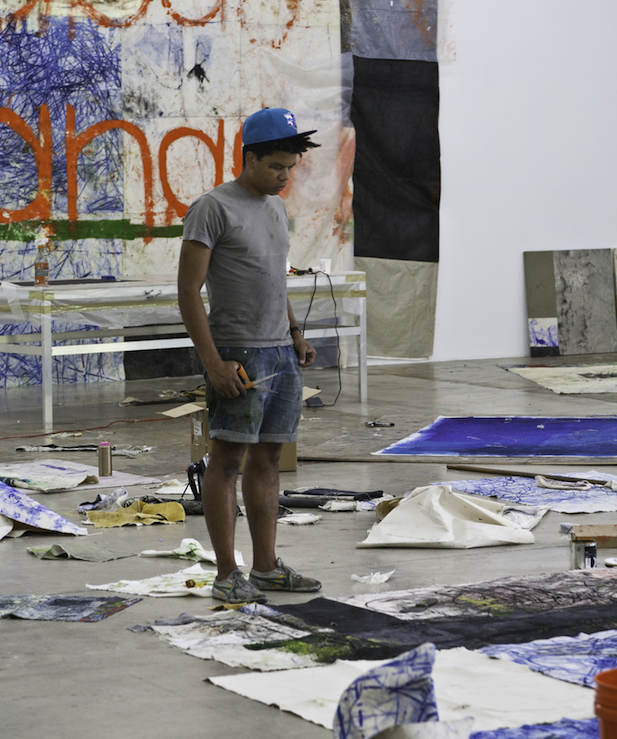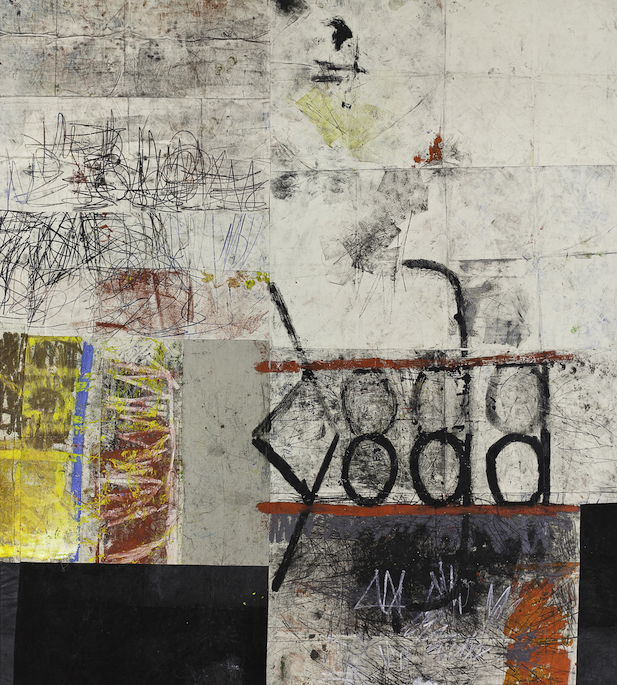ARCHIVE
OSCAR MURILLO
words by Isobel Harbison

Courtesy of the artist and Rubell Family Collection, Miami; Stuart Shave/Modern Art, London; Isabella Bortolozzi Galerie, Berlin; and Carlos/ Ishikawa, London
Wolfgang Tillmans’s photograph after party (2002) shows a vacated studio, seen through mirrors resting against a wall. Daylight pours in. Its gray floor is blackened with last night’s footprints. Around the edges of the image, dirty plastic tumblers stand upright and beer bottles rest on their sides. No body is in the shot. This photograph is like a pause between the previous night’s euphoria and the dull pain of today, between a group’s din and the silence of one. Oscar Murillo’s work, although neither photographic nor figurative, also functions in this interstices.
Murillo makes paintings and instigates social gatherings. In every studio that he works in, he builds a raised timber platform ten centimeters off the floor that extends to the room’s perimeter. According to the artist, the decision to make this structure is less about creating a space for theatricality than generating room for production. It becomes the support structure upon which the paintings are produced, a flat easel on which the painterly action is performed, the base against which the pigment is rubbed and studio dust will inevitably fall. And here, he is not the only worker. Murillo often invites dancers, amateur and professional, to carry out his tasks. In the Royal College interim show in 2011, dancers treaded upon a roughly-hewn carpet made of strips of canvas in I’d take you there, but it doesn’t exist any more (2010–11). Later that year, over the course of two performances, similar elements were reconfigured. In animals die from eating too much! yoga (2011) at Hotel gallery in London, several young women performed yoga positions upon mats made from rectangles of diversely colored fabric laid over low-lying wooden plinths, a meditation-cum-spectacle for the audience to observe. In another version, performed several weeks later at Carlos/Ishikawa gallery, animals die from eating too much – bingo! (2011), the yoga mats were repurposed as table cloths covering more elevated platforms, upon which visitors could congregate and play, eat and socialize, and around which the same ensemble of dancers freely circulated. Across his practice, platforms and people are treated and repositioned, often reappearing up-cycled into different versions. And although the circumstances change, the people, platforms and fabrics often travel with Murillo as he goes from one residency or exhibition to the next, picking up the dirt of his studios and the provenance of his own biography.

Courtesy of the artist and Rubell Family Collection, Miami; Stuart Shave/Modern Art, London; Isabella Bortolozzi Galerie, Berlin; and Carlos/ Ishikawa, London
In keeping with the physical movements of his dancers, his canvases have been displayed in various ways too: hung on the wall, resting against it, or laid out on the floor. In some recent exhibitions — notably in one with Stuart Shave at the 2012 Independent fair — all of the component props, platforms and canvases were shown together. The paintings themselves are often abstractions, rendered predominantly in black, brown or blue, applied with a commonplace domestic object, like a broom, across the surface of a material in a manner that allows it to penetrate through its weave onto its underside, which is often the side that is displayed. The paint picks up day-to-day dirt as it is absorbed, and the combination of stressed fabric, paint and grime gives the work a domestic intimacy like a well-worn carpet or a cluttered, dusty shelf. Across his timber platforms, Murillo creates what he describes as a primitive printing press. He imagines his works like monoprints, with the fabric and debris of everyday life as his basic paper, picking up the contours of his movements and his dancers, and the rest impressed by the household implements that he uses in lieu of printer’s blocks.
Murillo’s compositions are nonfigurative in the sense that they do not depict bodies in space, although they often include elements that resemble graffiti: isolated nouns describing basic provisions or activities — milk, chorizo, yoga — scrawled in large letters using bold-colored oils. Formally, they resemble the efforts of some early Abstract Expressionists or sophisticated graffiti artists, but their significance goes beyond their mannered appearance. For Murillo, they signify agents that bring people together in celebration, the food or drink of the parties in Europe or his native Colombia, for example, that he occasionally puts on for friends and family — gatherings that both explicitly and implicitly feed his work. In a recent performance in Paris, Edoardo’s 45th Birthday Party (2012), Murillo invited his personal entourage to the celebration of his fictional friend in the upmarket apartment of a French collector, along with a group of guests invited by his gallery. He recounted to me in conversation the awkwardness of this situation but insists that once champagne and food were served, it subsided, and people relaxed and coalesced. He explained the occasion was not an attempt to objectify his friends and family but rather to continue to integrate or weave his personal life into his evolving professional life as an artist.
Courtesy of the artist and Rubell Family Collection, Miami; Stuart Shave/Modern Art, London; Isabella Bortolozzi Galerie, Berlin; and Carlos/ Ishikawa, London
In its attempted integration of the physical and public with the pictorial and personal, Murillo’s practice might echo many earlier performative approaches, from the Japanese artists in the Gutai Group — in which painting was performed on the horizontal, floor-bound canvas by bodies swinging, sweeping or crawling across its surface (a notable example being Kazuo Shiraga’s use of his feet to paint, in the mid1950s) — to the rambunctious strokes of Yves Klein’s blued-up female nudes moving over blank canvases in front of awe-struck bourgeois crowds in the early days of Art Informel (IKB, 1959). But while there are undoubtedly similarities between physical approaches, the tone and attitude of Murillo’s works seems distinct from these avantgardes. In contrast to their antagonisms, his work seems at home in the cultural context of 2012. While earlier cross-disciplinary practices sought to break from the confines of the pictorial plane in a way that mirrored the breaks with social and political constrictions following World War II, Murillo’s fluid trans-disciplinarity is entirely emblematic or symptomatic of the comportment of his own generation, whose boundaries dissipate as one’s personal and professional lives merge as they self-profile and self-commodify across a host of platforms in order to remain visible and employable.
Indeed, commodities continually reappear in Murillo’s work, featured as props or as the subject of performances. In work just happens (2012), Murillo carried out a series of yoga exercises at the center of an ancient amphitheatre in Arles, on the occasion of the exhibition “To the Moon via the Beach” organized by LUMA Foundation. Yoga, a practice of early Hindu philosophy co-opted by the 21st century health-and-beauty industry, seems representative of the kind of transitions that take place regularly within Murillo’s practice. Here exercises in individual meditation become a form of public connectivity, family become spectacle to collectors, the exotic becomes consumable and instances of private life are willingly exposed. Then, the artist’s experience is reified into painting. In his most recent solo exhibition at the Rubell Family Collection in Florida, a new series of large paintings were hung. On Yoga (2012), a patchwork of dirty monochromes, the title is imprinted twice, pressed and inversed through the canvas’s fold. Just as fabric provides an actual ground for the physical or social encounter, it is then reconstituted back into a painting and the cycle of spectacularisation, normalisation and re-commodification begins once more. Murillo’s works are cyclical in this sense. In his words, the painting and performances are not polar parts of his practice but “circular [...] catching relationships and moments as they cross over.” Like a bare studio covered in last-night’s dirt, soaked in the promise of new morning light.



